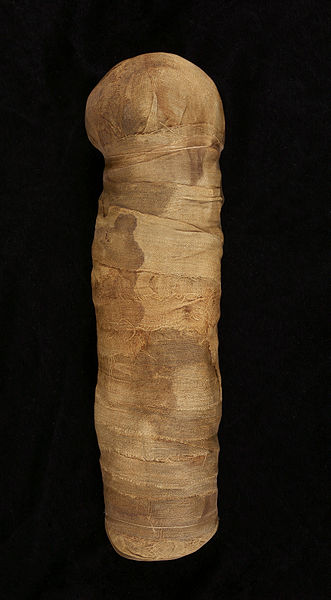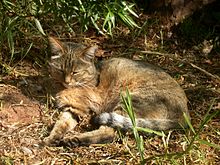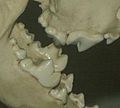This is a continuation of my blog series, Part of the Family.
So now that we understand how humans are related to other primates, going all the way back to before the asteroid impact 65 million years ago, it's time to figure out how our pet cats figure into this family equation. Like my best buddy, Galileo:
We adore them, pamper them, and love them. Some of us do all of that while sneezing our faces off. But why? What's so stinkin' cute about a widdle puddy tat?
Well, first off all...ever notice how humans are much more likely to find other mammals cute, rather than say, a bird, or a snake, or a lizard, or a frog? Sure, some of us just find everything adorable, but the average person is going to be way more warm-fuzzied by something that is, well, warm and fuzzy.
And that makes sense. We tend to feel most protective towards creatures that share more of our genes. Why? Because we're programmed to feel that way. By our genes. (Is your mind blown yet?)
We share the vast majority of our genes with the common domestic cat, just as we do with any mammal. But cats (and dogs for that matter) are not the most closely related mammal to primates. Regardless of our personal feelings, as a human, you're more closely related to a rat than you are to your precious Mr. Mittens McFluffytail. Can't pick your relatives, right?*
So if we should feel more protective towards things we're more closely related to, why do most people prefer cats to rats? Obviously, things are much more complicated than simply ranking your favorite creatures by the percentage of DNA you share. Cats have wormed their way into our hearts, beating out our closer rat relatives, by improving the odds of our human relatives' survival (which totally trumps everything else). So good job, cats. You've essentially beaten the system.
Our relationship with cats has slowly developed over time to be one of mutual assistance. They help us keep our food safe from rodents, we in turn protect them from predators and ensure they don't starve.
 |
| Cat with kitten amulet, 400 BC |
 |
| Mummy cat, 400-200 BC |
There is evidence that this relationship with cats may predate the ancient Egyptians. In a burial dated to 9500 years ago from Cyprus, a human was found carefully laid to rest with a cat.**
Whatever the case, we've been hanging with cats for millenia. That's long enough that the cat may have actually influenced the past few thousand years of human evolution. It could be that we've had a slow selection acting on us to favor people who like, or at least tolerate, cats milling about in their lives. They're helpful, after all. It would not surprise me to learn that we have a collection of genes that effectively give us "cat tolerance".
But beyond our current social relationship with cats, what about our genetic one? How to felines actually relate to primates?
 |
| Sand cat. |
The modern domestic cat is part of the genus Felis, which includes several species of small cats such as the sand cat of northern Africa and the Middle East.
 |
| African Wild Cat. |
Before 10 million years ago, these cats would've been part of a larger group called the subfamily Felinae, which again, is mostly small cats, but does include the ancestors to the cheetah and the cougar. So if you've ever wondered which big wild cats your pet is most closely related to, there you go.
 | |
| Creepy thought of the day: the Cheshire Cat must eat meat to survive. |
 Carnivora is an order that's broken up into two suborders, the feliforms and the caniforms. Guess which one your cat is from? Yep, the suborder Feliformia. Guess which one dogs are from? Duh, Caniformia. Now guess which one those nasty Lion King hyenas were from?
Carnivora is an order that's broken up into two suborders, the feliforms and the caniforms. Guess which one your cat is from? Yep, the suborder Feliformia. Guess which one dogs are from? Duh, Caniformia. Now guess which one those nasty Lion King hyenas were from?Feliformia. Yep. Hyenas are more closely related to cats than to dogs.
Anyhow, the two suborders split around 42 million years ago. One major distinguisher between the two is how their auditory bulla (or ear bone covering) is formed. Feliforms have a double-chambered one, caniforms have a single-chambered one. Might not sound fascinating, but its these sorts of differences that are key for paleontologists, who work with bones. Other differences include the behavior of feliforms to be more ambush-y in their hunting strategy than caniforms, but that's a lot harder to tell from the bones.
Sadly, another difference is that feliforms are usually more forest-based, so that means we have a terrible fossil record for them. Bones degrade quickly in forest environments are rarely have time to fossilize.
So onwards (or backwards) to the next big split: the Carnivora from the rest of the Eutherians (non-marsupial mammals). This is finally where we'll see what drove apart cats from humans!
 |
| There is no such thing as a saber-toothed tiger. |
 |
| Carnassials! |
So now we're almost to the point where our cats lineage joins up with our own. Carnivora branched off before 65 million years ago. But even earlier in time that, there is one last branching event to talk about. The branch that separated one major group of mammals from another, long before the infamous asteroid struck Earth and cleared the way for mammals to take over.
On one side of this branch are the carnivores, the camels, pigs, goats, giraffes, the whales, the horses and the rhinos, the shrews, and the hedgehogs, among many others.
The other side includes the rabbits, the rodents, and the primates. In other words, us.
Major split. And probably happened over 90 million years ago. The only physical characteristics that tell these groups apart may be some features of the skull around the ear. The split itself was probably just an element of location. The group the cats belonged to came from the supercontinent, Laurasia, while our group seemed to originate from islands off the coast of this supercontinent.
So some 90-odd million years ago, the last common ancestor of cats and humans had one of its members swept up and out to sea to land on some islands near the coastline. Our last common ancestor would've looked quite a bit different from either of us, but would've had a few recognizable features. It would've had hair on its body. It would've had teeth that came in the form of molars, premolars, canines, and incisors. And it would've given birth to live young, attached via a placenta, which it then would have nursed with milk.
Above is an artist rendition of Eomaia, 125 million years-old, and one of the early ancestors of humans and cats alike. Maybe she doesn't look like much, but she gave rise to a really cool batch of animals.
Now, maybe you're saying to yourself...wow. This was a lot to read. It sure took a while to get to the point back in time where humans and cats really were one and the same. We're not that closely related, after all!
If that is indeed what you're thinking...just wait until you see how we're related to the ground up coffee beans used in your morning latte.
* I adore rats, for the record. And they will be the focus of a future "Part of the Family" blog post.
** I am not an archaeologist, and do not know if this discovery is controversial within the field or generally accepted as an actual indication of early cat domestication. If anyone more informed does know, please chime in!
Citations:
Benton MJ. 2005. Vertebrate Paleontology: Third Edition. Malden, Massachusetts: Blackwell Publishing Ltd.
Johnson W.E., Eizirik E., Pecon-Slattery J., Murphy W.J., Antunes A., Teeling E. & O'Brien S.J. 2006. The Late Miocene radiation of modern Felidae: A genetic assessment. Science 311: 73–77.
Pecon-Slattery J. and O'Brien S.J. 1998. Patterns of Y and X chromosome DNA sequence divergence during the Felidae radiation. Genetics 148: 1245–1255.
Prothero DR. 2004. Bringing Fossils to Life: An Introduction to Paleobiology: Second Edition. New York, NY: McGraw-Hill.



"Is your mind blown yet?"
ReplyDelete...Yes. Cats rule.